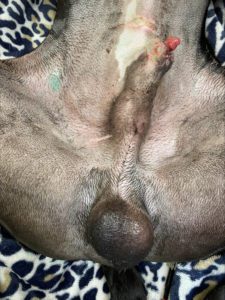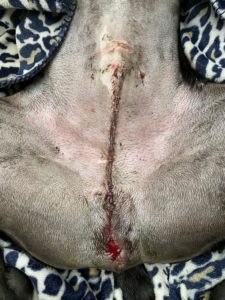
Thor, a 2-year-old, 100 lb Great Dane, was in a tough and strange situation.
He had a condition called paraphimosis. This means that being intact (i.e. not neutered), he got a bit excited with his female Great Dane buddy, and could not get his penis back in his prepuce (a.k.a. his sheath).
This cut off the circulation.
I’m going to try to keep this story PG 13, so let’s just say that Thor’s penis turned back and purple.
It became so seriously compromised (necrosis), that his family vet wisely recommended the only option possible: removing Thor’s penis (i.e. a penile amputation).
His owner remembers: “I don’t think words could describe how I was feeling. I felt so bad that my baby would have to go through this surgery and have his entire life turned upside down. I was scared for him. I cried so much. I still do when I think about it. But I knew it had to be done.”
Thor’s family vet was able to put the penis back into the prepuce and keep it in there by loosely stitching the opening of the prepuce. That would prevent any further damage to the penis.
Below is a PG13 picture of Thor before surgery:

Amputation of the penis is mainly performed for severe trauma to the penis (paraphimosis like in Thor, dog bites etc.) or tumors of the penis or the prepuce. Another reason for paraphimosis is something called “hair rings,” where hair gets matted or entangled around the base of the penis, and blocks the circulation – like a tourniquet.
Once the penis is removed, we still need a way to allow the patient to pee.
So the 2nd step of the surgery is a urethrostomy, which is a way to create a new opening. Technically, the lining of the urethra (i.e. the tube coming out of the bladder that ends up in the penis in a male) is sutured to the skin.
In Thor’s case, the urethrostomy was performed in the ideal location, which is where the testicles are. So he was neutered, and his scrotum (the “sac”) was removed as well.
Thor did well through surgery and anesthesia.
Below is a picture of Thor after surgery:

Possible complications of this procedure include:
- Postop bleeding. This area is very rich in blood vessels, so bleeding should be expected for up to 3 weeks.
- Bruising and swelling are possible after any surgery and can be expected here.
- Urine scald (or burn). Urine can be irritating to the skin. The hope is that the dog will learn (or continue) to squat to pee, which should minimize the amount of leakage on the skin. If it happens, it should be cleaned and dried meticulously, every single time. Prevention is much easier than treating urine scald.
- Shrinking (a.k.a. stenosis or stricture) of the urethrostomy site. This is typically avoided with experience. This surgery is generally performed by a board-certified surgeon. Licking of the area increases this risk, so a plastic cone (E collar) is mandatory for at least 3 weeks.
Logically, dogs with tumors are likely to have a less favorable outcome than dogs with trauma, but it all depends on the type of tumor and whether it was completely removed or not.
In the end, Thor did great overall. Once home, his energy and attitude progressively got back to normal. His owners were happy with the outcome.
He did learn to squat, which reduced skin issues. He did have to be cleaned and he made it easy for his owners by rolling on his back after peeing!
Thor’s owner concludes: “I have honestly learned some very valuable lessons from this. The first is to make sure your dogs are fixed (neutered or spayed).”
3 weeks after surgery, Thor had his stitches removed at his family vet.
She sent the following picture:

And she very kindly commented: “Thank you for addressing Thor so quickly, providing him the life-saving surgery he needed, and taking such excellent care of him!!”
If you would like to learn how we can help your pet with safe surgery and anesthesia, please contact us at www.HRVSS.com.
Never miss a blog by subscribing here: www.HRVSS.com/blog
Phil Zeltzman, DVM, DACVS, CVJ, Fear Free Certified

